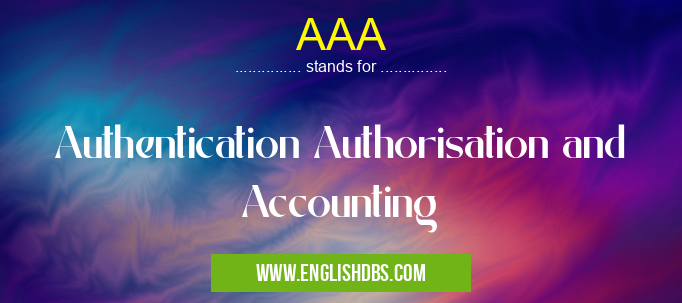What does AAA mean in GENERAL
AAA (Authentication, Authorization and Accounting) is the process of verifying user credential for secure access to a computer network or system. This process combines three distinct functions to ensure user identity, secure access privileges, and record/track user activity. In most cases, AAA services are hosted on dedicated servers that can provide authentication services to many different users or devices. The need for AAA has grown significantly over the years as data security becomes increasingly important in business and personal contexts alike.

AAA meaning in General in Computing
AAA mostly used in an acronym General in Category Computing that means Authentication Authorisation and Accounting
Shorthand: AAA,
Full Form: Authentication Authorisation and Accounting
For more information of "Authentication Authorisation and Accounting", see the section below.
Essential Questions and Answers on Authentication Authorisation and Accounting in "COMPUTING»GENERALCOMP"
What is AAA?
AAA stands for Authentication, Authorization, and Accounting. It is a security architecture that provides user authentication, authorization for access to resources, and tracking of usage activity. It is used to verify the identity of users before allowing them access to network resources and track their activities for auditing purposes.
What types of authentication are used in AAA?
The most common type of authentication used in AAA is username/password combinations. Other forms such as digital certificates, tokens, and biometrics can also be used depending on the security needs of the organization.
What type of authorization is provided by AAA?
AAA provides authorization based on user credentials provided during authentication. This means that different levels of access can be granted or denied based on the specific roles and privileges associated with a user’s identity.
How does accounting work with AAA?
Accounting in an AAA system tracks user activity within a network in order to monitor usage patterns and uncover unauthorized activities or violations of policy. It records all logon attempts, resource access requests, data transfers between systems, etc., so that administrators can review user activity for compliance with corporate policies or government regulations.
What are the benefits of using an AAA system?
Implementing an AAA system brings many benefits including improved security, increased visibility into user activity, simplified management of access rights, better control over resources and infrastructure, reduced IT costs due to automation processes made possible by centralized administration tools, ability to audit large amounts of data quickly and accurately; improved compliance with regulatory requirements; reduction in fraud; simplified investigation process if suspicious behavior is detected; more effective enforcement & monitoring of network resources; enhanced maintenance & reliability; faster mean time-to-repair (MTTR).
Why might an organization choose not to use an AAA system?
Organizations may not wish to use an AAA system because it requires additional hardware investments which could be costly for certain environments such as small businesses or governments without larger budgets. Furthermore implementing such a system can require significant human resources as well since its installation requires specialized knowledge and training.
Is an AAA system always necessary for secure networks?
Not necessarily - many organizations do not need the full protection offered by an extensive AAA system. A basic firewall setup may be enough if there's no need for remote access or intricate network configurations that require advanced security measures such as two-factor authentication or encryption protocols. It will depend on each individual organization's needs but ultimately it's important to weigh up the pros and cons before investing in any solutions as they may not always prove cost effective depending on your environment.
Are there risks associated with implementing anAAA system?
Yes - although these risks may vary according to the implementation process itself (for example how secure passwords are stored), there are generally some potential issues that must be taken into account when using this technology such as susceptibility towards malicious attacks (including denial-of-service) due to issues like weak encryption algorithms or database vulnerabilities. Additionally if a flawed implementation restricts too much access it could pose a risk to business operations due to lack of flexibility.
Final Words:
AAA (Authentication Authorisation and Accounting) is an essential component of modern data security solutions because it helps ensure only authorized individuals have access to sensitive information. It also allows organizations to track user activity so they can identify malicious behavior early on if necessary. By combining all three levels into one service administrators can easily manage their systems without having to configure each piece individually. With so much reliance on digital protection today it’s vital for companies to ensure they use strong AAA solutions that keep their data safe from unauthorized users or cybercriminals.
AAA also stands for: |
|
| All stands for AAA |
